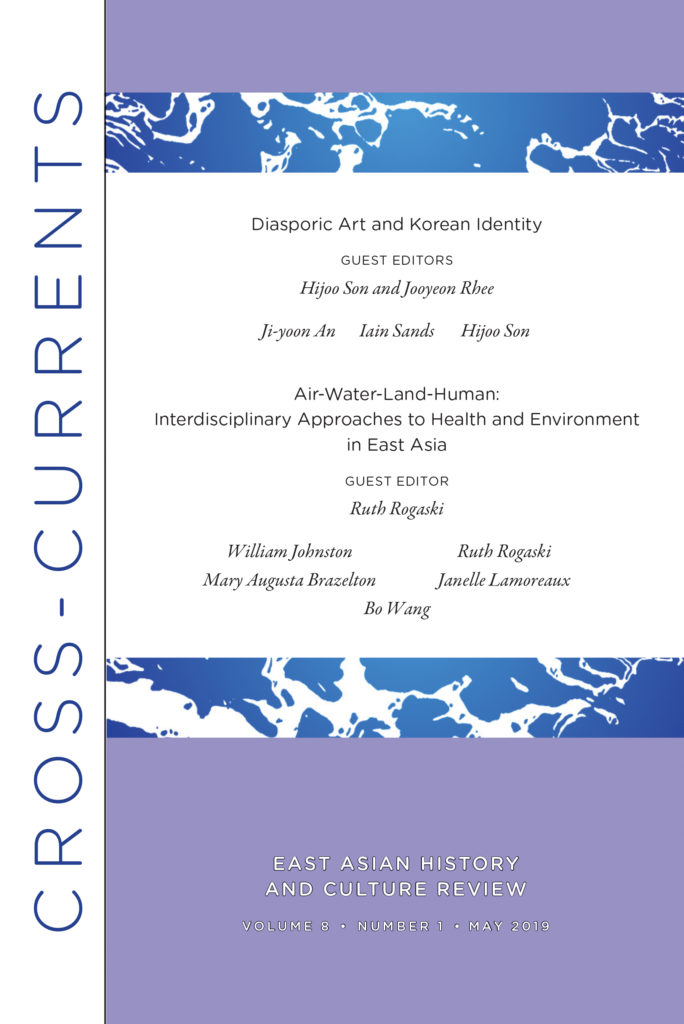The journal offers its readers up-to-date research findings, emerging trends, and cutting-edge perspectives concerning East Asian history and culture from scholars in both English-speaking and Asian language-speaking academic communities. The journal seeks to balance issues traditionally addressed by Western humanities and social science journals with issues of immediate concern to scholars in China, Japan, Korea, and Vietnam. Cross-Currents includes material from the sixteenth century to the present day that have significant implications for current models of understanding East Asian history and culture.
Cross-Currents is indexed in the Emerging Sources Citation Index (ESCI), Scopus, the Bibliography of Asian Studies, and Project MUSE.
Print Issues available for purchase:
8#1, 2019 includes special sections on Diasporic Art and Korean Identity, guest edited by Hijoo Son and Jooyeon Rhee.
This special section, titled “Diasporic Art and Korean Identity,” is the fruit of a two-day conference on “Korean Diaspora and the Arts” held at The Hebrew University of Jerusalem in May 2017. The contributors explore new delineations of the political, social, cultural, and emotional landscapes inhabited by Koreans living in diaspora. Korean diasporic artists investigate the meaning of “Koreanness” through their paintings, political cartoons, theater, film, documentary, photographs, and multimedia art. The topic of diaspora—which Gabriel Sheffer defines as “ethnic minority groups residing and acting in host countries while maintaining material and sentimental ties to their homelands”—has received impressive scholarly attention in the humanities and social sciences, and Korean diaspora studies has been part of this trend (Sheffer 1986, 3).Special Section, Air-Water-Land-Human: Interdisciplinary Approaches to Health and Environment in East Asia, guest edited by Ruth Rogaski.
If East Asia has been defined by particular ideas about the intertwining of humans and the environment, it also gives us a reality in which humans and the environment are frequently at odds. Philosophies may have preached the harmony of the macrocosm and human microcosm, but this did not stop people from exploiting and harming the environment for centuries with catastrophic impact on human health (Elvin 2008; Perdue 1987; Totman 1989). The advent of capitalist development and its accompanying neoliberal philosophies have accelerated these processes to unimaginable effect. Indeed, it is impossible to think about East Asia today without touching on destructive links between humans and the environment, whether manifest in the nuclear catastrophe at Fukushima, cancer villages in Sichuan, or bird flu pandemics emerging from Vietnam (Walker 2010; Lora-Wainwright 2013a; Porter forthcoming 2019). Historian Brett Walker’s observation about Japan holds true for all of East Asia: scholars “can no longer be content to ruminate on Japan’s exquisite harmony with nature” but must instead “explain how it has contributed to regional ecological collapse and global climate change” (Walker 2013, xiii).
Also available online in Project MUSE!
Other recent back issues:
7#2 Recent Research on North and South Korea
Writing Revolution Across Northeast Asia, guest edited by Steven S. Lee
7#1 Binding Maritime China: Control, Evasion, and Interloping, guest editors Eugenio Menegon, Philip Thai, and Xing Hang
6#2 Maps and Their Contexts: Reflections on Cartography and Culture in Premodern East Asia, guest edited by Robert Goree
Naming Modernity: Rebranding and Neologisms during China’s Interwar Global Moment in Eastern Asia, guest edited by Anna Belogurova
Order print copies by contacting: University of Hawai’i Press, 2840 Kolowalu Street, Honolulu, HI 96822, Toll-free (U.S. & Canada): Tel. 1-808-956-8833 Fax 1-808-988-6052 Tel. 1-888-UHPRESS Fax 1-800-650-7811 Email: [email protected] $25.00 per issue





